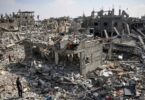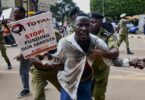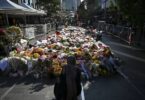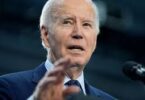Mehraj Din
After the abrogation of Articles 370 and 35A of India’s constitution, the Indian administered region of Jam-mu and Kashmir is in its seventh month of a controlled siege while the ri-ght-wing government of Prime Minister Narendra Modi has imposed strict control over the flow of information out of the region. It is a frightening reality on the ground and its unimaginable representation emerges every day through various international media platforms.
On Aug. 5, the ruling party – BharatiyaJanta Party – unilaterally violated the fundamental conditions of the Instrument of Accession, by which the former princely State of Jammu and Kashmir acceded to India in 1947, quashing the lingering Kashmiri hopes for self-determination. This devastating decision brought the valley fully under the control of New Delhi.
The action strips the state of Jammu and Kashmir of its special status – which includes its right to have its own constitution and its own flag. It also strips it of statehood and partition into two union territories – Jammu Kashmir and Ladakh. In preparation for this, it put Kashmir into a complete lockdown at midnight on Aug. 4. Seven million Kashmiris were barricaded in their homes. In an effort to impose a complete communication blockade, internet connections were cut and phone connections were terminated.
Everything seems to have come to a halt, and the past experiences have started to conjure the images of unprecedented violence. Since the revocation or illegal annexation of Kashmir on Aug. 5, the betrayed and besieged population, including me, treated like a prisoner in a forsaken paradise on earth, continue to mourn India’s deceptively organized virulent manifestation of democracy.
The problem of Kashmir: It is imperative to understand the brief context of the conflict to understand the contemporary politics of this place. “The world is reaping the chaos the British Empire sowed,” Amy Hawkins wrote in Foreign Policy, and “locals are still paying for the mess the British left behind in Hong Kong and Kashmir.”
The anti-colonial uprisings in the Indian subcontinent, China, the Arab world and elsewhere did not result in freedom or democracy for the nations ruled by the British Empire. In Kashmir, the British left a bleeding wound amid the partition of colonial India. Kashmir in post-partition and to be more succinct, post-1947 emerged as a boiling pot from the cultivation uterus of the two-nation theory.
Though the problem of Kashmir traces its genesis to before the emergence of India and Pakistan as independent countries, the question of Kashmir continues to remain a perennial bone of contention between two nuclear-armed countries – India and Pakistan. Both the states have fought three wars against each other since 1947, the first two of which were over Kashmir and the confrontation on the borders [LOC] continue to escalate tensions between India and Pakistan.
The continuous repression of the common population culminated into armed rebellion in the last decade of the 20th century (1989), which afterward was neutralized through massive counterinsurgency operations. What transpired afterward, while democracy was thriving in the world, the Indian government offered to lend an ear to Kashmiris only if they shift from “armed resistance” to “non-violent peaceful mass movement,” the manifestation of which was visible in uprisings in 2008 and 2010, and even before that, when the world was yet to experience the phenomenon of the Arab Spring. The mass non-violent peaceful democratic movement again resulted in the same authoritarian brutalization leaving more than 200 people dead. Their families were left shattered until the memories of their loved ones either faded from their memory or the families experienced more brutal manifestations of violence.
After the large-scale Kashmir uprising in 2016 – following the death of BurhanWani and the Indian state’s brutal violence through over 100 killings and over a thousand partial and complete blindings including those of teenagers and children, ParthaChatterjee, a famous historian wrote for the newspaper The Telegraph that the uprising was a consequence of a recipe for treating Kashmir as a colonial possession.
Today Kashmir is one of the most heavily militarized zones in the world. More than 7 million soldiers have been deployed, as per the reports, to counter what the Indian army itself admits is now just a handful of “Islamist terrorists.” This myth has been busted time and again because of the actions of the Indian government in the last three decades and the past three months. If there were any doubts earlier, they should have cleared by now. Their real enemy is the Kashmiri people, especially “Kashmiri Muslims” as was also reiterated by Pakistan’s President Imran Khan in a U.N. general assembly speech.
What India has done in Kashmir over the last 70 years is unimaginable for the world and unforgivable. An estimated 70,000 killed, thousands disappeared, dozens of women raped, hundreds lost their sight due to pellet guns, tens of thousands have passed through torture centers like Abu Gharib. Most militants operating in the valley today, who have personally experienced the brute manifestations of violence, are young Kashmiris, armed and trained locally. They do what they do knowing that the minute they pick up a gun, their “expected lifespan” is likely to be less than six months; some last only 48 hours, as is the case with an assistant professor in sociology, Mohammad Rafi, of Kashmir University. Each time a gun-holding boy is killed, Kashmiris turn up in tens of thousands to bury the dead body whom they venerate as a “shaheed,” a martyr.
BharatiyaJanta and Article 370: This is exactly what transpired as soon as the BJP government led by Modi entered the parliament with a full majority for their second term in power. One of the primary trump cards, pre and post elections revolved around the Pulwama attack and their promise of scrapping Article 370/35-A to formally assimilate Kashmir by diluting the demography and scrap it of its distinct identity.
Though it took many by surprise, the decision to abrogate Article 370 was not unheard of. Modi’s ruling BharatiyaJanata Party (BJP) had long harbored the desire to revoke Kashmir’s nominal autonomy and normalize its status within India. For Indian nationalists, Article 370 and its associated provisions had become a symbol of Kashmir’s “incomplete” integration into the rest of the country.
This abrogation of Article 370 can be seen as part of Modi’s larger Hindu nationalist project: centralizing power and suppressing the claims of national minorities. India has long failed to make the promise of democracy alluring to Kashmiris. India thinks it has won Kashmir, but it might be losing the soul of its democracy in the process.
To understand the political theology working in the background, BJP’s policies and actions in the past five years have clearly demonstrated that it considers the Kashmir dispute as one revolving around religion, one between Hindu India and Muslim Pakistan, discarding any charade about the need to consult the people of the state. It unapologetically argues a territorially irredentist claim to Kashmir and, indeed, the state of J&K in its entirety.
Silent vote and veto: Going on for the last seven decades, Kashmiris have survived the most brutal and violent counterinsurgency operations, enduring the perennial never-ending physical, economic, sociopsychological trauma. The signs of which continue to be evident in the infliction of state violence that Huma Dar, an anthropologist based in US hyperlinks to, in terms of unmarked mass graves, routine sexual violence and torture, massacres and enforced disappearances and “fake encounters.”
More than 80,000 troops entered the valley before Article 370 and 35A were scrapped. Kashmiris continue to suffer in agony as they resist the so-called democracy. The residents continue to suffer under a despotic regime suppressing dissent with draconian laws like AFSPA, a communication blackout and an internet shutdown. Consider, for example, mass arrests of pro-resistance political activists, a ban on religiopolitical movement (JamaatIslami), pre and post scrapping of Article 370 and 35A. Even mainstream pro-Indian politicians (including three former chief ministers) who served and safeguarded the Indian government’s interests in the state were arrested . They ensured the imposition of indefinite curfews across Kashmir during the day for weeks on end which made it impossible for ordinary citizens to buy daily supplies and prevented those needing medical attention from reaching a hospital among other debilitating consequences.
Every action of suppression hinged upon a common thread – to break the political will of the Kashmiri population and their legitimate democratic demand for the right to self-determination. Followed by this continuous onslaught to break the political will manifested in the form of e-war, virtually silencing more than 7 million voices to reach the outside world, the term neo-modern jail aptly defines the current situation in Kashmir.
What abrogation of the already diluted article has done for Kashmiris is an erosion of that middle ground used as a cover by the Indian government to rule Kashmir through the local collaboration with Kashmiri mainstream political parties. Talking to dozens of Kashmiris, the revocation of this article is mainly seen as an irreversible hegemonic assault on Kashmiri Muslim identity and to completely annihilate and crush the political dissent in the valley.
The censorship has reached its new low, not like the time of Indira Gandhi’s emergency days. Now with considerable media houses following the line of the government, with few exceptions, they are totally serving the narrative of Hindutva – an ideology seeking to establish the hegemony of Hindus and the Hindu way of life.
The media coverage in the local newspapers and editorials sings of unprecedented fear and submission to the diktats of the current dictatorial fascist regime. The local media coverage, as confirmed by many local journalists, who don’t want to be named due to the crackdown on any dissenting voice, unanimously agreed to this unfortunate reality, of writing a false history vis-a-vis the reportage and editorials published in international media.
The truth of defiance: This season’s siege is more crushing than ever, possibly the worst since the first one nearly 30 years ago, a stratagem designed carefully to humiliate an entire people. There is also an unwavering manifestation of defiance, as by now the Kashmir street is sufficiently educated politically to not pin its hopes on an infusion of benevolence in the government’s Kashmir policy or any practical outcome from the concern of the international community.
The mass arrests, in thousands, including minors and pellet victims (including a cancer patient), holding 7 million populations under 800,000 jackboots have unrivaled the farcical facade of Indian democracy. No government in the world has blocked internet access as frequently as India – an incredible 159 times in just three years, which is far more than Syria, Iran, Turkey and Egypt. Amid such fear, even whispers have been silenced, Abid Khan, 28, and Idrees, 29 from Shopian district were raided in the middle of the night, tortured for hours by dozens of army men. Khan says he was dragged out and blindfolded along with his brother, who has learning difficulties, on Aug. 14. “They gave electric shocks to my brother right on the road outside. I heard him scream painfully,” he quoted in Agence France-Presse (AFP), as saying, showing marks on his arms, legs and buttocks. Khan said: “Then they gave me electric shocks again on my genitals and wounds. One of them said ‘I will make you impotent.'” On Sept. 13, Irshad Ahmed, a 12-year-old boy from neighboring Buchpora, Srinagar, suffered a serious head injury. His hospital registration card noted that it was a “fire-arm injury,” adding the word “alleged.” Despite such violence against innocent civilians, their defiance to oppression lives on. What’s coming?
One uncontested fact that successive union governments since India’s first Prime Minister Jawaharlal Nehru have deliberately ignored is the people of Kashmir. This recent political expedition of the Indian government has further pushed the local population toward forced alienation and inevitable political radicalization.
My interviews and interactions with Kashmiri people reveal two major responses – deep anguish and contempt against the Indian state with perennial angst for war as the only solution. This is worrying but quite understandably plausible, after looking at the history of betrayals perpetrated by the Indian state against the people of Jammu and Kashmir.
The pro-India political parties in Kashmir, who unwaveringly and willingly, estimating the benefits of co-option, executed the political agenda of Delhi in Kashmir now face a trial as never before. They must go beyond the Aug. 4 Gupkar Declaration, as suggested by A. G. Noorani, a lawyer of international repute in his Frontline magazine article Murder of Insaniyat. He further argues that Kashmiris should prepare a manifesto of the united movement of Kashmir and take to the streets, after renouncing all forms of violence. Today people in places like Palestine and Kashmir see themselves as stateless nations ruled with brutish military occupation. In the postcolonial game of state formation, they have been denied their national sovereignty.
Neither India in Kashmir nor Israel in Palestine can have a day of peaceful domination until and unless the defiant nations they rule and abuse achieve and sustain their rightful place in the world. While the abrogation of Article 370 has worrying consequences beyond Kashmir, this is what has become apparent: Kashmiris and those who know what continues to happen in Kashmir are aware of the fact that the postcolonial nationalist elites maintained the structures of power they had inherited from the colonial experience. After gaining independence for their countries, they often aggressively pursued the very same colonial policies they had fiercely fought against during the colonial period.
Everyone irrespective of class, color or religious distinction believes that the response of Kashmiri youth to the atrocities being committed by the Indian government has been ferocious. The response, to what has now happened, that has literally threatened their identity and future through illegal annexation, can be disastrous.






